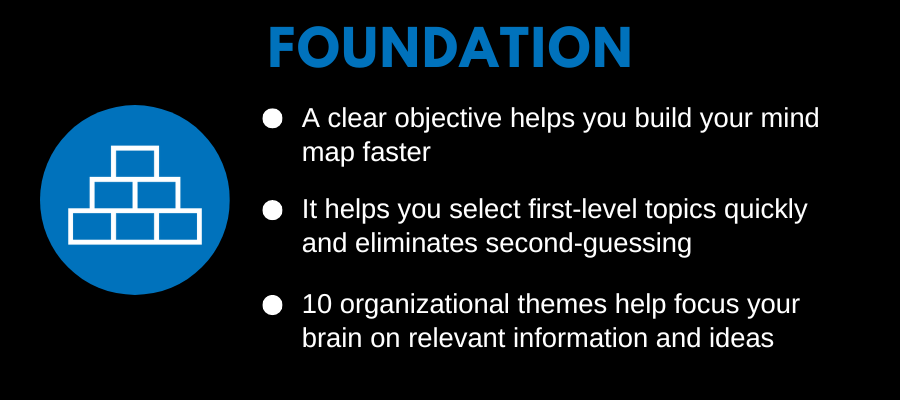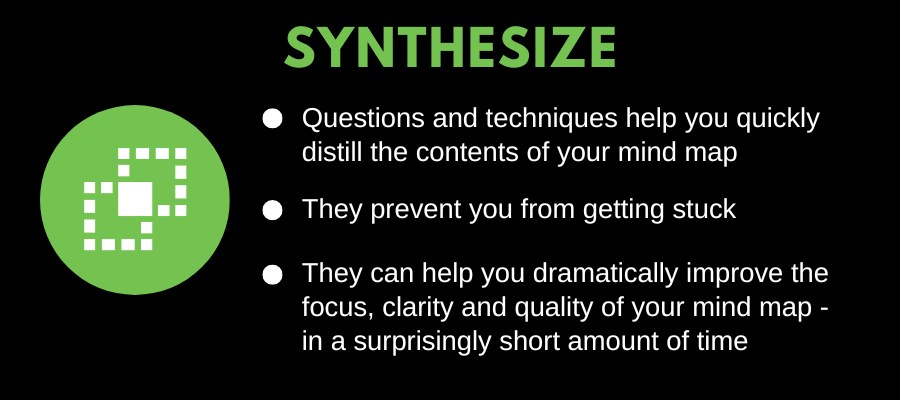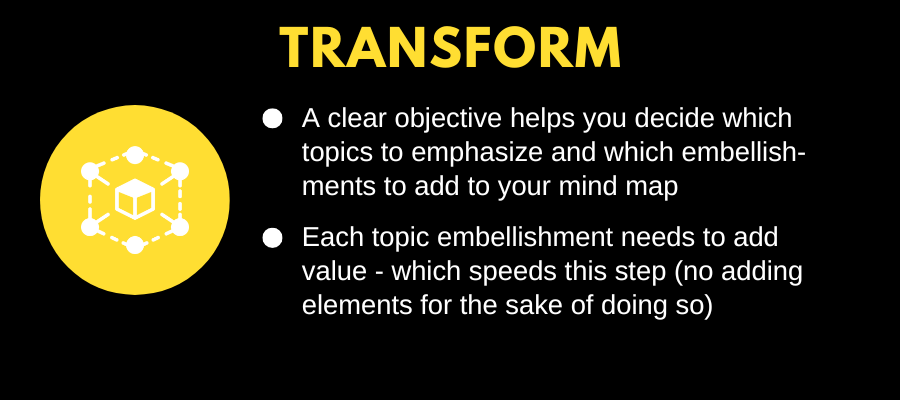
Are you challenged by how long it takes to build a high-quality mind map? Here’s how the F.A.S.T. framework can help you create high-quality mind maps, significantly faster than before.
When I first created the F.A.S.T. framework for effective mind mapping, I was overwhelmingly focused on helping users of mind mapping software to improve the quality of their creations and reach CLARITY. I didn’t focus on the speed of creating a mind map. Obvious, right? It is, after all, the FAST framework. But at the time, it wasn’t my focus.
Now times have changed. Business is being disrupted like never before. COVID. AI seems to be everywhere, affecting everything. Global uncertainty. Accelerating innovation on every front. Entrepreneurs and executives need to create excellent content, reports and diagrams – fast.
This got me thinking about mind mapping, and why more people aren’t using it to its full potential. I realized that one of the reasons people give up it may be because it takes them TOO LONG to create a mind map they’re happy with.
So I stepped back and looked at the F.A.S.T. framework from the lens of SPEED. I asked myself, “How does this framework save its users time, keep them focused on the right practices and produce exceptional mind maps – faster than if they just played around with it on their own?” I discovered a lot of value!
But before I walk you through that, I want to frame our discussion around three key concepts:
- The value of frameworks,
- The real significance of the Pareto principle (the “80/20 rule”), and
- The unseen effects of DRAG on your work.
The fundamental purpose of a framework
When you have a tool, you only have POTENTIAL power. If you have a system or process that can help you to get the most out of it, you can accomplish 5, 10 or even 100 times more!
Here are some of the ways in which a framework can help you accelerate your success in just about any area of your life:
- It can save you a tremendous amount of time
- It reduces wasted effort and the frustration that comes with it
- It helps you focus on and leverage best practices
- It provides you with shortcuts that can help you achieve the results you seek, faster
- It acts as a priceless guide to focus your thinking along a proven, successful process. It’s a multiplier for your effectiveness.
- It allows beginners to make progress and experts to progress faster
- It can help you to transform chaos into clear, orderly thinking and planning
- A good framework can also help you to make better-informed decisions
- A good framework empowers you. You may not have all the answers, but you know how to use a good process to arrive at them faster and more reliably
Notice how four of the benefits of frameworks are focused on speed.
That’s not a coincidence.
If you’re serious about being productive and reaching your goals faster, frameworks can be a powerful accelerator.
That’s a drag, man
Another key benefit of a framework is that it can reduce or eliminate drag. In aerodynamic terms, drag is anything that interferes with an object’s ability to move through the air (such as an airplane or a race car). When it comes to work, drag is anything that doesn’t create value.

Reduce or eliminate drag and you can go faster.
Are you seeing the connection here?
If you can eliminate time-consuming steps that don’t add value, that would enable you to work faster, right?
A framework brings the Pareto Principle (the 80/20 rule) to life. By helping you focus on the 20% of actions that provide the biggest impact, they enable you to eliminate the drag caused by the 80% of activities that don’t add value. Less drag means greater velocity.
So how does the F.A.S.T. framework help you work faster and reduce drag when creating mind maps?
Let’s take a closer look at the four steps of the F.A.S.T. framework through the lens of SPEED:
Foundation
If you have a clear objective – what you want to communicate, who your audience is and what you want them to do after reading your mind map – you’ll be able to build it faster, because you’ll have a focus for your efforts.
Having an objective or purpose for your mind map naturally focuses your brain and channels your thoughts, so you can quickly record them as topics within it.
Without a clear purpose, you can quickly end up with a morass of topics – which can make you feel stuck and can kill your productivity. Or you may end up wasting time pursuing a number of paths that ultimately turn into dead ends.
The foundation stage of building a mind map is all about selecting the right first level topics. It’s easy to imagine many mind mappers getting stuck here, unsure of what to add and not wanting to make a mistake.
This chapter of the course lists 10 ways to focus your map’s first-level topics, inspired by Tony Buzan. Selecting one can help you get your mind map off to a faster start. These ideas act as stimuli to get your mind moving – in the process, accelerating the development of your mind map.
Associate
Now that you have finalized your map’s first-level topics, it’s time to start building out the content of your mind map. One of the reasons mind maps are such powerful tools is because they mirror the way your brain thinks – by association.
There are a number of techniques you can use to support your powerful brain during this process. They can definitely help you to grow it faster – at the speed of thought.
Idea triggers are powerful tools that most people undervalue. They’re satisfied with brute thinking – unaided brainstorming where you simply add whatever top of mind ideas you have in the moment to your mind map.
But this approach tends to be very limiting, because usually the thoughts you have at any given time aren’t the most creative.
Using idea triggers stimulates your mind to think in new, fresh directions. It also helps you think faster than simply staring at the wall and hoping for Inspiration to strike.
The bottom line is that a focused, creative approach to building out the content of your mind map can help you to do so faster AND elevate its value.
Synthesize
Synthesis consists of combining and strengthening related ideas. You need to decide what’s essential, and focus on making those areas of your map as strong as possible.
During this step of the F.A.S.T. framework, you mentally take a step back from your mind map to view it from a higher level. You assess the content of your mind map with a critical eye. This step is similar to a painter stepping back from the canvas to assess the brush strokes they’ve added so far and to consider their next steps.
But this step in creating a mind map is perhaps the least intuitive of all. How do you distill the content of a mind map to improve its clarity, fill in missing pieces and increase its value? No one provides you with a road map for how to do this.
You’re on your own.
This is where many mind mappers get stuck. They’ve created a diagram that contains a fair amount of detail. But it isn’t well organized – and it isn’t clear what they need to do in order to make it make sense.
The course suggests a number of approaches and questions to ask that can help you dramatically improve the focus, clarity and overall quality of your mind map in a surprisingly short amount of time.
Transform
During this final step of the F.A.S.T. framework, you add topic enhancements that multiply the utility and value of your mind maps.
A framework doesn’t necessarily help you embellish your mind map faster, but it brings a strong focus to your efforts that makes this step more purposeful and efficient.
On one level, this stage ties back to your objective at the beginning of the process: What’s the purpose of your mind map? Who is the audience who will be reading it? What action do you want them to take as the result of doing so?
That objective will dictate what you should emphasize or draw their attention to as you put the finishing touches on your mind map. It will also help you to select topic enhancements that make sense, that actually add value to it.
This level of focus helps ensure that you don’t get bogged down adding a bunch of colors, icons and other enhancements to your mind map that don’t add meaning and context. Yes, by bogged down, I DO mean wasting time. Staying focused on your objective lets you quickly add only those essential touches that will increase the clarity of your mind map.
Conclusion
Clearly, using a framework can help you produce high-quality, clear, concise mind maps significantly faster than if you didn’t use one. To make this comparison abundantly clear, here is a visual that compares the typical approach to mind mapping to utilizing the F.A.S.T. framework:

To learn more about this 4-step process and how it can accelerate your mind map output, why not take a deeper dive into the F.A.S.T. framework?

Want to know more about what’s included in the F.A.S.T. Framework for Effective Mind Mapping course? Want to learn what others are saying about it?





Leave a Reply